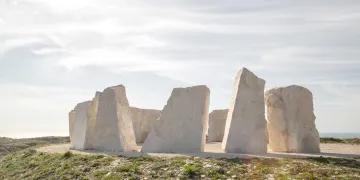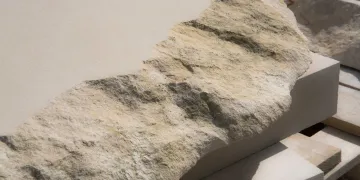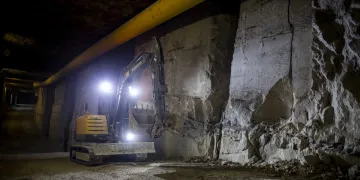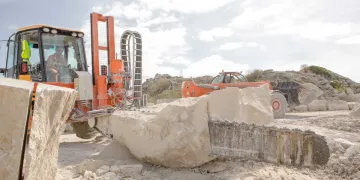The Isle of Portland proffers no ordinary stone but one of Britain’s most treasured natural resources – known for both its easily recognisable and varied features, and for its contribution to the character of the nation’s capital city. Many of London’s most iconic landmarks are constructed from Portland Stone, including Buckingham Palace, St Paul’s Cathedral and the Tower of London. This stone is written into the city’s history books and will now adorn the walls of Chelsea Barracks.
In use since Roman times – particularly when the desired architectural effect is one of grandeur – Portland Stone is distinctly British, and an icon in its own right, making it a clear choice for the façade of Chelsea Barracks. Herein lies the story of this remarkable stone, quarried from the protected ecological sites of Portland, on the Jurassic coast of southern England.
Inigo Jones, the Royal architect of the 17th Century, and his masons, laid the foundations for the Portland Stone industry, overcoming the challenges of harsh winter storms, pirates and landslides to build on Portland an industry that would supply the stone for London’s most splendid buildings for centuries to come. Unlike established masonries in Bath and Oxford, Portland had the distinct advantage of being by the sea – enabling the transportation of the stone to the centre of London with relative ease. Here, Jones began the construction of Covent Garden and St Paul’s Cathedral.

These early projects required relatively modest quantities of Portland Stone, and it wasn’t until the 18th century – when Sir Christopher Wren endeavoured to re-build London following the great fire of 1666 – that the industry truly flourished. Portland has been intrinsic to the building of London ever since and is exported all over the world to this day.
Portland stone’s popularity amongst architects has transcended time and fashion, the reason for which lies in its unique physical properties. Portland Stone is a type of limestone that has formed over the last 140-150 million years, containing on average 95 per cent calcium carbonate. This creates the pure milky colour for which it is now famous. The stone in this small concentration of land has distinct and various layers, creating a collection of closely related textures – each with its own distinct character and qualities, depending on its age.

The three main variants are:
Portland Basebed – With an almost velvety appearance, this smooth and creamy stone is excavated from the deepest layer of Portland and is therefore the oldest. The powder like finish offers complete consistency. Basebed will be the principal material used for the façades of 8 & 9 Whistler Square and 1 Mulberry Square.
Portland Whitbed – This is the middle layer of Portland stone and offers a slightly textured palette, with soft colour variations throughout and minor remnants of fossils formed over millions of years. The Whitbed will clad the façades of the Chelsea Barracks Townhouses.
Portland Roach – Sits neatly on top and is therefore the youngest Portland Stone. It has the most colour variation and is wonderfully textured, with fossilised shells and extinct marine life from 130-145 million years ago visible in every piece. Roach will surround the entrance to 8 Whistler Square, where the fossils and imprints of the fascinating prehistoric marine life can best be admired.

Stone had been excavated from Portland in opencast quarries for the last 300 years, when hand tools and horse and cart were used to extract and transport tonnes of stone to London and further afield. However, the continuous demand for the desirable stone has left a mark on the island, with many disused quarries now covering the upper surface. Due to the ongoing environmental impacts, operations moved underground in 2008, when the first mine opened on Portland. Here, mining and island life can coexist happily as operations expand out of site. While mining is largely considered a thing of the past in Britain, on Portland, the stone mining industry is still in its infancy.
The mine is laid out on a 6m x 6m grid, with roadways 6m wide and 4m high to allow for the custom-made machinery to travel. However, the varying depths at which the desirable stone can be found varies enormously throughout the mine – in some places 17-18 m below surface level – making it extremely difficult to identify and remove at times. To extract the stone, large saws make insertions into the rock, where metal plates are then inset into the gaps and pumped full of water. This creates huge pressure, causing the stone to break so it can be removed. Each individual block can take up to 12 hours to extract.

Once removed, the stone is given an individual identification number, so it is traceable as it goes through the factory. This is crucial to the operation, as stone must be put onto a building in the same natural orientation that it comes out of the ground, to ensure a continual horizontal grain wraps around the buildings. This is an intricate and highly skilled procedure, and in Portland, it is executed to perfection.
In a country that is so often grey, Portland stone is defiant – it takes what little light there is, shines and smiles. On a glorious summer’s day, a Portland building is a beacon, grand and gleaming against the blue sky – and endlessly classic. Unlike concrete, stucco or steel, this enduring material is a timeless treasure synonymous with London. It is a nod to the architectural heritage of the city, as well as a comforting indication of what is to come.


